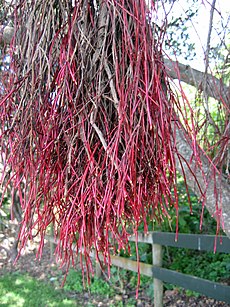Aerial root - Simple English Wikipedia, the free encyclopedia


An Aerial root is a root which is above the ground. Different plants have grown them. They can have different functions:
- For support: Sometimes such roots are grown for support. Ivy plants have them to cling to structures, such as stone walls, or other trees. The Banyan tree (also known as strangler fig) grows them downward from branches into the forest floor. Eventually, the host tree dies.
- Roots for breathing: Some plants grow in environments where there is much water in the soil. They may then grow such roots (upwards) to breathe air. Black mangroves have such roots, for example.
- As a parasite. Parasites sometimes grow these, into the host to get nutrients. One example of this is the mistletoe.
- Roots to propagate: Some plants have above-ground roots. In some places, little plants (with leaves and roots) develop. They will drop off at some point, and develop into new plants (that are clones of the parent). Examples for this are strawberries or the spider plant.
Images[change | change source]
- A Fig has its fruits on an aerial root
- Another Pōhutukawa tree with an aerial root coming from a branch
- Close-up of the aerial root


 French
French Deutsch
Deutsch

